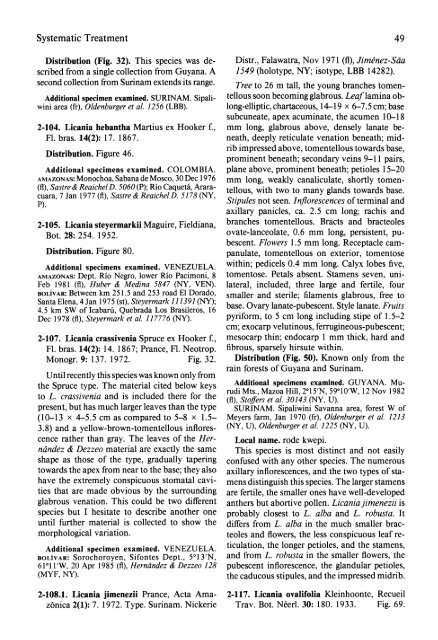flora neotropica - CNCFlora
flora neotropica - CNCFlora
flora neotropica - CNCFlora
You also want an ePaper? Increase the reach of your titles
YUMPU automatically turns print PDFs into web optimized ePapers that Google loves.
Systematic Treatment 49<br />
Distribution (Fig. 32). This species was described<br />
from a single collection from Guyana. A<br />
second collection from Surinam extends its range.<br />
Additional specimen examined. SURINAM. Sipaliwini<br />
area (fr), Oldenburger et al. 1256 (LBB).<br />
2-104. Licania hebantha Martius ex Hooker f.,<br />
Fl. bras. 14(2): 17. 1867.<br />
Distribution. Figure 46.<br />
Additional specimens examined. COLOMBIA.<br />
AMAZONAS: Monochoa, Sabana de Mosco, 30 Dec 1976<br />
(fl), Sastre & Reaichel D. 5060 (P); Rio Caqueta, Araracuara,<br />
7 Jan 1977 (fl), Sastre & Reaichel D. 5178 (NY,<br />
P).<br />
2-105. Licania steyermarkii Maguire, Fieldiana,<br />
Bot. 28: 254. 1952.<br />
Distribution. Figure 80.<br />
Additional specimens examined. VENEZUELA.<br />
AMAZONAS: Dept. Rio Negro, lower Rio Pacimoni, 8<br />
Feb 1981 (fl), Huber & Medina 5847 (NY, VEN).<br />
BOLiVAR: Between km 251.5 and 253 road El Dorado,<br />
Santa Elena, 4 Jan 1975 (st), Steyermark 111391 (NY);<br />
4.5 km SW of Icabaru, Quebrada Los Brasileros, 16<br />
Dec 1978 (fl), Steyermark et al. 117776 (NY).<br />
2-107. Licania crassivenia Spruce ex Hooker f.,<br />
Fl. bras. 14(2): 14. 1867; Prance, Fl. Neotrop.<br />
Monogr. 9: 137. 1972. Fig. 32.<br />
Until recently this species was known only from<br />
the Spruce type. The material cited below keys<br />
to L. crassivenia and is included there for the<br />
present, but has much larger leaves than the type<br />
(10-13 x 4-5.5 cm as Distr., Falawatra, Nov 1971 (fl), Jimenez-Sda<br />
1549 (holotype, NY; isotype, LBB 14282).<br />
Tree to 26 m tall, the young branches tomentellous<br />
soon becoming glabrous. Leaf lamina oblong-elliptic,<br />
chartaceous, 14-19 x 6-7.5 cm; base<br />
subcuneate, apex acuminate, the acumen 10-18<br />
mm long, glabrous above, densely lanate beneath,<br />
deeply reticulate venation beneath; midrib<br />
impressed above, tomentellous towards base,<br />
prominent beneath; secondary veins 9-11 pairs,<br />
plane above, prominent beneath; petioles 15-20<br />
mm long, weakly canaliculate, shortly tomentellous,<br />
with two to many glands towards base.<br />
Stipules not seen. Inflorescences of terminal and<br />
axillary panicles, ca. 2.5 cm long; rachis and<br />
branches tomentellous. Bracts and bracteoles<br />
ovate-lanceolate, 0.6 mm long, persistent, pubescent.<br />
Flowers 1.5 mm long. Receptacle campanulate,<br />
tomentellous on exterior, tomentose<br />
within; pedicels 0.4 mm long. Calyx lobes five,<br />
tomentose. Petals absent. Stamens seven, unilateral,<br />
included, three large and fertile, four<br />
smaller and sterile; filaments glabrous, free to<br />
base. Ovary lanate-pubescent. Style lanate. Fruits<br />
pyriform, to 5 cm long including stipe of 1.5-2<br />
cm; exocarp velutinous, ferrugineous-pubescent;<br />
mesocarp thin; endocarp 1 mm thick, hard and<br />
fibrous, sparsely hirsute within.<br />
Distribution (Fig. 50). Known only from the<br />
rain forests of Guyana and Surinam.<br />
Additional specimens examined. GUYANA. Murudi<br />
Mts., Mazoa Hill, 2?15'N, 59?10'W, 12 Nov 1982<br />
(fl), Stoffers et al. 30143 (NY, U).<br />
SURINAM. Sipaliwini Savanna area, forest W of<br />
compared to 5-8 x 1.5- Meyers farm, Jan 1970 (fr), Oldenburger et al. 1213<br />
3.8) and a yellow-brown-tomentellous inflores- (NY, U), Oldenburger et al. 1225 (NY, U).<br />
cence rather than gray. The leaves of the Her- Local name. rode kwepi.<br />
ndndez & Dezzeo material are exactly the same This species is most distinct and not easily<br />
shape as those of the type, gradually tapering confused with any other species. The numerous<br />
towards the apex from near to the base; they also axillary inflorescences, and the two types of stahave<br />
the extremely conspicuous stomatal cavi- mens distinguish this species. The larger stamens<br />
ties that are made obvious by the surrounding are fertile, the smaller ones have well-developed<br />
glabrous venation. This could be two different anthers but abortive pollen. Licaniajimenezii is<br />
species but I hesitate to describe another one probably closest to L. alba and L. robusta. It<br />
until further material is collected to show the differs from L. alba in the much smaller bracmorphological<br />
variation.<br />
teoles and flowers, the less conspicuous leaf re-<br />
Additional specimen examined. VENEZUELA. ticulation, the longer petioles, and the stamens,<br />
BOLiVAR: Sorochoroyen, Sifontes Dept., 5?13'N, and from L. robusta in the smaller flowers, the<br />
611 1'W, 20 Apr 1985 (fl), Herndndez & Dezzeo 128 pubescent inflorescence, the glandular petioles,<br />
(MYF, NY).<br />
the caducous stipules, and the impressed midrib.<br />
2-108.1. Licania jimenezii Prance, Acta Ama-<br />
zonica 2(1): 7. 1972. Type. Surinam. Nickerie<br />
2-117. Licania ovalifolia Kleinhoonte, Recueil<br />
Trav. Bot. Neerl. 30: 180. 1933. Fig. 69.

















